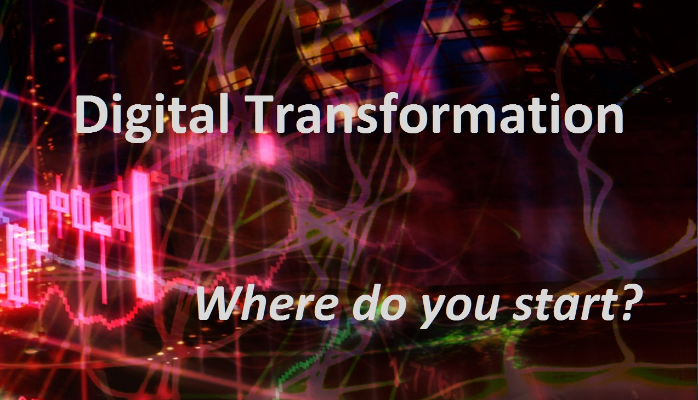Getting Lost is Easy!
Part 2
Digital Transformation – Mobile, Cloud, them Things, and that really Big Data
We’ve all heard that the Internet of Things (IoT) and data analytics are essential to future success of organizations. Almost every day, like me, I am sure you’re bombarded with a new event on the topic. Having spent a long time in the emerging technology and innovation area, I thought I’d attend one of the more established IoT conferences and see what all the fuss is about. I inherently dislike paying good money and spending valuable time at an event to hear nicely concealed sales pitches. But at this IoT event, to add insult to injury, I actually found myself lost half-way through the event. I thought I was alone in this, so I casually broached the topic at lunch with several other people. It turned out that they were in the same boat. The conversations over breaks, evening networking sessions, and hallway chats only reaffirmed the general sense of bewilderment. And this audience was mainly people in the tech-innovation space.
After hearing from 250+ different IoT platform vendors, half a dozen different interoperability/ standardization bodies, and many dozens of vendors who made sensor chipsets, “things”, radio networks, gateways, and analytics engines – one realizes the problem. It’s a classic tale of technology hype and lofty promises of what “can be” on one side and the reality (some may call these shackles) of legacy business. Between the two sides, you’ll find confused decision makers.
Where do you start? A rooftop patio is a great place
Over dinner on a rooftop patio on one of our warm winter evenings, I had an eye opening moment with a client who manages a large number of complex and diverse infrastructure assets. We were discussing the value of data analytics and the role IoT could play. His view was that before his organization could think of big data, they had to get credible, reliable and usable data first. They had no shortage of data – it’s just that the data they had was inconsistent, in different formats, and resided in disparate systems. Hence the level of confidence they had in its efficacy for decision making was questionable, especially in a highly regulated industry. I asked him why? He explained that they couldn’t even consistently identify an asset because they used stick-on bar codes that would peel off, wash off, or just get scratched. So, in such cases, the maintenance staff would write the information on a paper and enter it into their system at a later time. Most of the time they could identify the assets correctly, but a large number of times they couldn’t. As a result, their degree of confidence in the large amount of data they had was limited.
Digital Transformation – Failure isn’t an option, it’s a requirement!
To me, the fore-mentioned discussion, illustrates a classic challenge organizations face. Their line of business operations folks have business problems, but don’t necessarily understand where to start their Digital Transformation (DX) journey or how to go about IoT and analytics. This is because, these things seem too far a stretch from the reality of where they are today.
The examples illustrate major barriers to adoption of IoT and analytics, and corporate-wide success of Digital Transformation. In addition, the absence of a return on investment (RoI), justifying implementation costs, and an inability to visualize tangible results, have also been cited as main challenges for adoption.
While the majority of large enterprises claim to be in the midst of Digital Transformation, the fact is that many of the same organizations, when asked to define Digital Transformation, couldn’t do so.
As an example, we can see the fore-mentioned dynamics at play in the banking sector. Financial institutions (FI) are generally encumbered with bureaucracy, legacy systems, and regulatory burdens. At the same time, they are faced with the onslaught of web and mobile-based offerings from a growing pool of financial technology (FinTech) startups. These over-the-top players are disrupting the traditional business of FIs.
As the business of FI’s is disrupted, much like Uber disrupted the taxi industry, the overarching question for the banks is whether or not there are compelling drivers to embrace DX. Justifying implementation costs and quantifying return-on-investment (RoI) may provide insight for decision making. However, becoming sidelined in your own industry, or being rendered obsolete, are business outcomes that can never be undone.
So, the risks are high – but where does one start? How does one really plan a viable DX journey? And how does one’s mindset and approach have to evolve to be successful?
“You may never have all the answers, so start, start small, be open to failing, learn quickly, refine your approach, and iterate! That’s the “fail fast” approach in a nutshell, you go from concept to proof-of-concept in several rapid iterations”
What people may not tell you is that, this requires a certain degree of discipline, and an appreciation for the art and science of “Design Thinking.” While organizations are starting to rapidly prototype and willing to fail fast – it’s no fun if you fail fast, fail everywhere, and just keep on failing.
A disciplined approach using “Design Thinking” that accords the latitude to experiment, learn, refine, and improve through discrete iterations is an art and a science.
Dawood Khan, CMC, P.Eng.
Freelance Contributor
Partner, RedMobile Consulting
